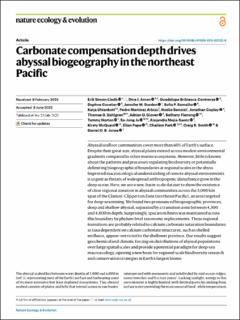| dc.contributor.author | Simon-Lledó, Erik | |
| dc.contributor.author | Amon, Diva J. | |
| dc.contributor.author | Bribiesca-Contreras, Guadalupe | |
| dc.contributor.author | Cuvelier, Daphne | |
| dc.contributor.author | Durden, Jennifer M. | |
| dc.contributor.author | Ramalho, Sofia P. | |
| dc.contributor.author | Uhlenkott, Katja | |
| dc.contributor.author | Arbizu, Pedro Martinez | |
| dc.contributor.author | Benoist, Noelie | |
| dc.contributor.author | Copley, Jonathan | |
| dc.contributor.author | Dahlgren, Thomas Gunnar | |
| dc.contributor.author | Glover, Adrian G. | |
| dc.contributor.author | Fleming, Bethany | |
| dc.contributor.author | Horton, Tammy | |
| dc.contributor.author | Ju, Se-Jong | |
| dc.contributor.author | Mejía-Saenz, Alejandra | |
| dc.contributor.author | McQuaid, Kirsty | |
| dc.contributor.author | Pape, Ellen | |
| dc.contributor.author | Park, Chailinn | |
| dc.contributor.author | Smith, Craig R. | |
| dc.contributor.author | Jones, Daniel O.B. | |
| dc.date.accessioned | 2023-08-21T08:04:45Z | |
| dc.date.available | 2023-08-21T08:04:45Z | |
| dc.date.created | 2023-08-15T14:12:14Z | |
| dc.date.issued | 2023 | |
| dc.identifier.citation | Nature Ecology and Evolution. 2023, . | en_US |
| dc.identifier.issn | 2397-334X | |
| dc.identifier.uri | https://hdl.handle.net/11250/3084956 | |
| dc.description.abstract | Abyssal seafloor communities cover more than 60% of Earth’s surface. Despite their great size, abyssal plains extend across modest environmental gradients compared to other marine ecosystems. However, little is known about the patterns and processes regulating biodiversity or potentially delimiting biogeographical boundaries at regional scales in the abyss. Improved macroecological understanding of remote abyssal environments is urgent as threats of widespread anthropogenic disturbance grow in the deep ocean. Here, we use a new, basin-scale dataset to show the existence of clear regional zonation in abyssal communities across the 5,000 km span of the Clarion–Clipperton Zone (northeast Pacific), an area targeted for deep-sea mining. We found two pronounced biogeographic provinces, deep and shallow-abyssal, separated by a transition zone between 4,300 and 4,800 m depth. Surprisingly, species richness was maintained across this boundary by phylum-level taxonomic replacements. These regional transitions are probably related to calcium carbonate saturation boundaries as taxa dependent on calcium carbonate structures, such as shelled molluscs, appear restricted to the shallower province. Our results suggest geochemical and climatic forcing on distributions of abyssal populations over large spatial scales and provide a potential paradigm for deep-sea macroecology, opening a new basis for regional-scale biodiversity research and conservation strategies in Earth’s largest biome. | en_US |
| dc.language.iso | eng | en_US |
| dc.rights | Navngivelse 4.0 Internasjonal | * |
| dc.rights.uri | http://creativecommons.org/licenses/by/4.0/deed.no | * |
| dc.title | Carbonate compensation depth drives abyssal biogeography in the northeast Pacific | en_US |
| dc.title.alternative | Carbonate compensation depth drives abyssal biogeography in the northeast Pacific | en_US |
| dc.type | Peer reviewed | en_US |
| dc.type | Journal article | en_US |
| dc.rights.holder | © The Author(s) 2023 | en_US |
| dc.description.version | publishedVersion | en_US |
| cristin.ispublished | true | |
| cristin.fulltext | original | |
| cristin.qualitycode | 2 | |
| dc.identifier.doi | 10.1038/s41559-023-02122-9 | |
| dc.identifier.cristin | 2167100 | |
| dc.source.journal | Nature Ecology and Evolution | en_US |
| dc.source.pagenumber | 13 | en_US |

